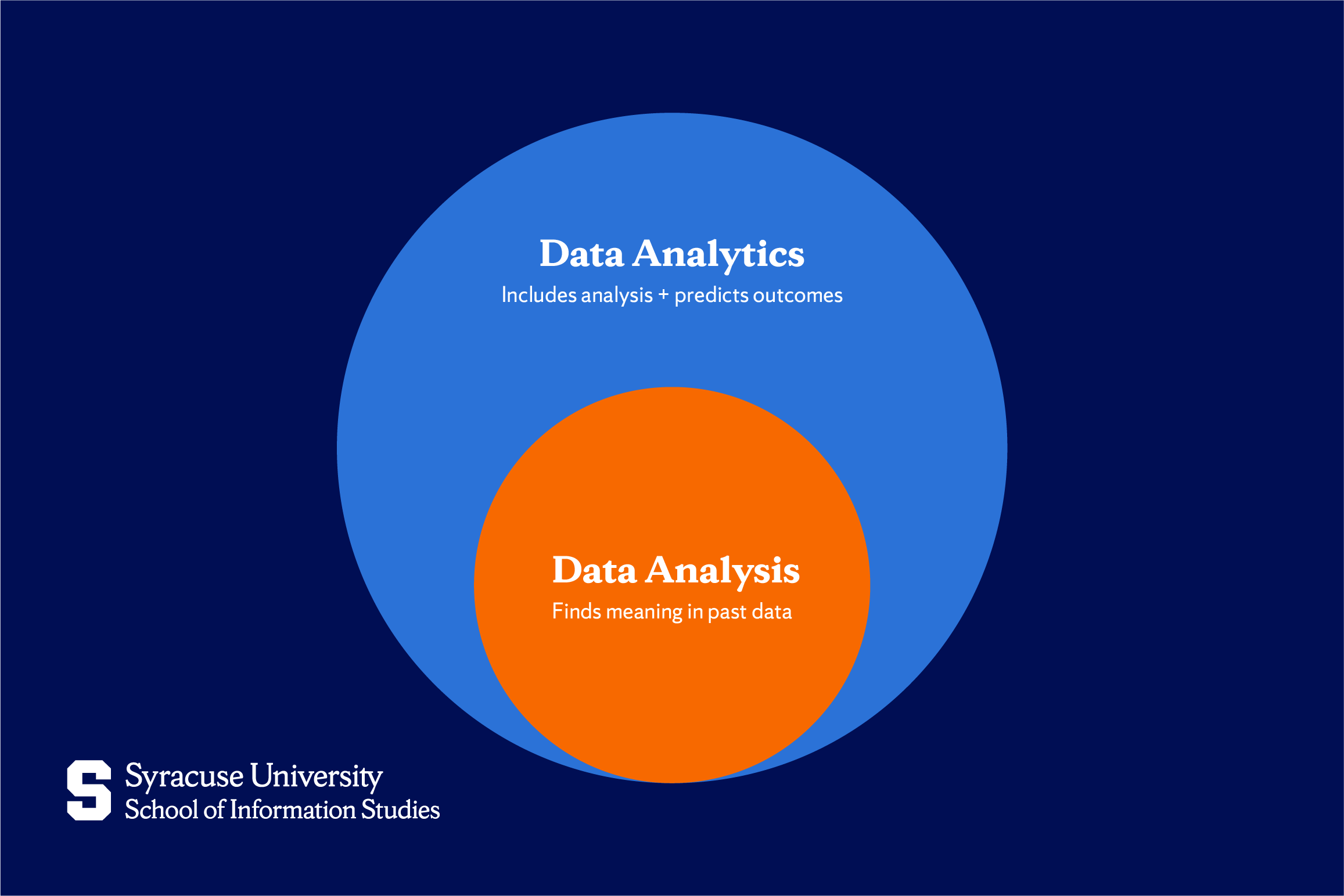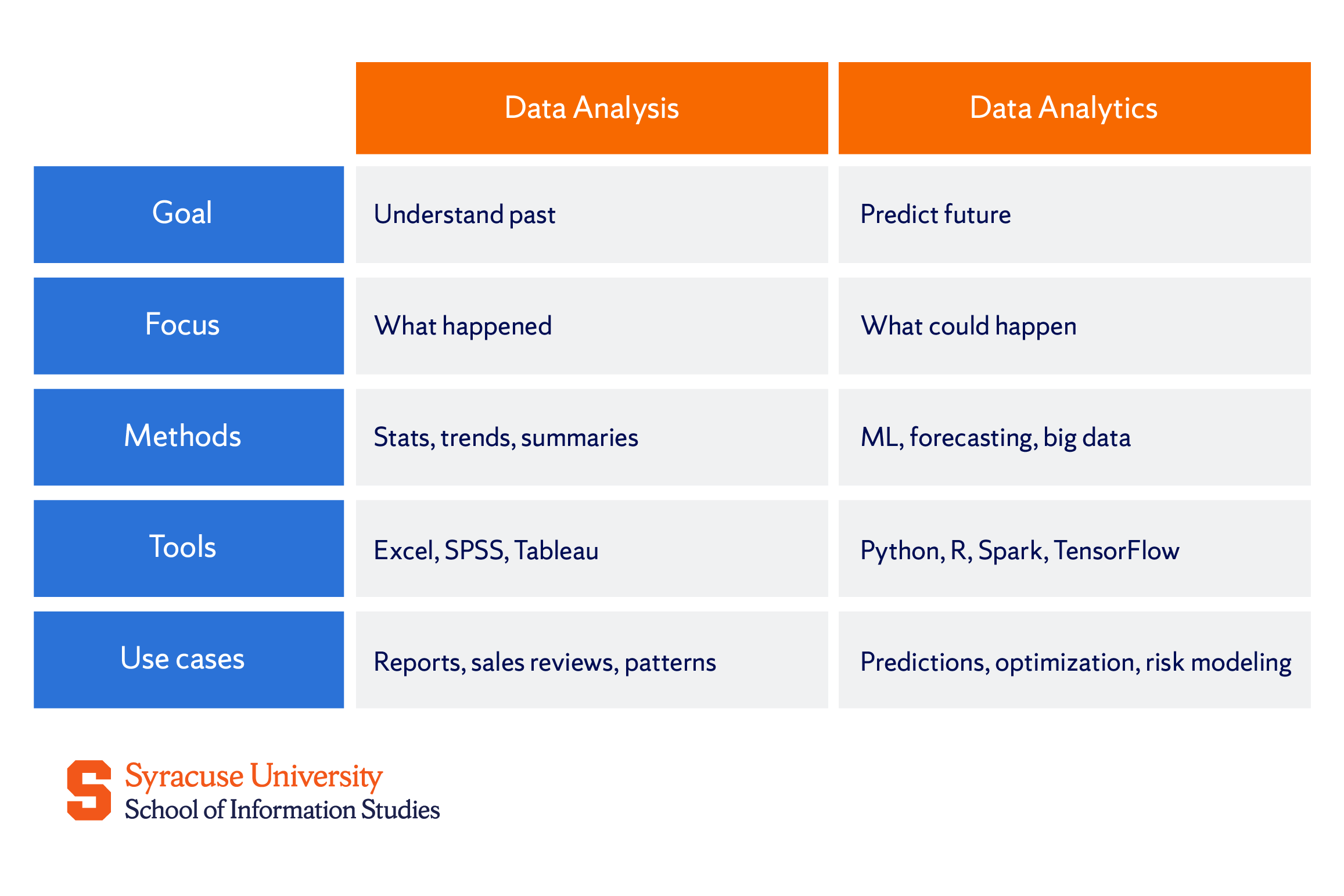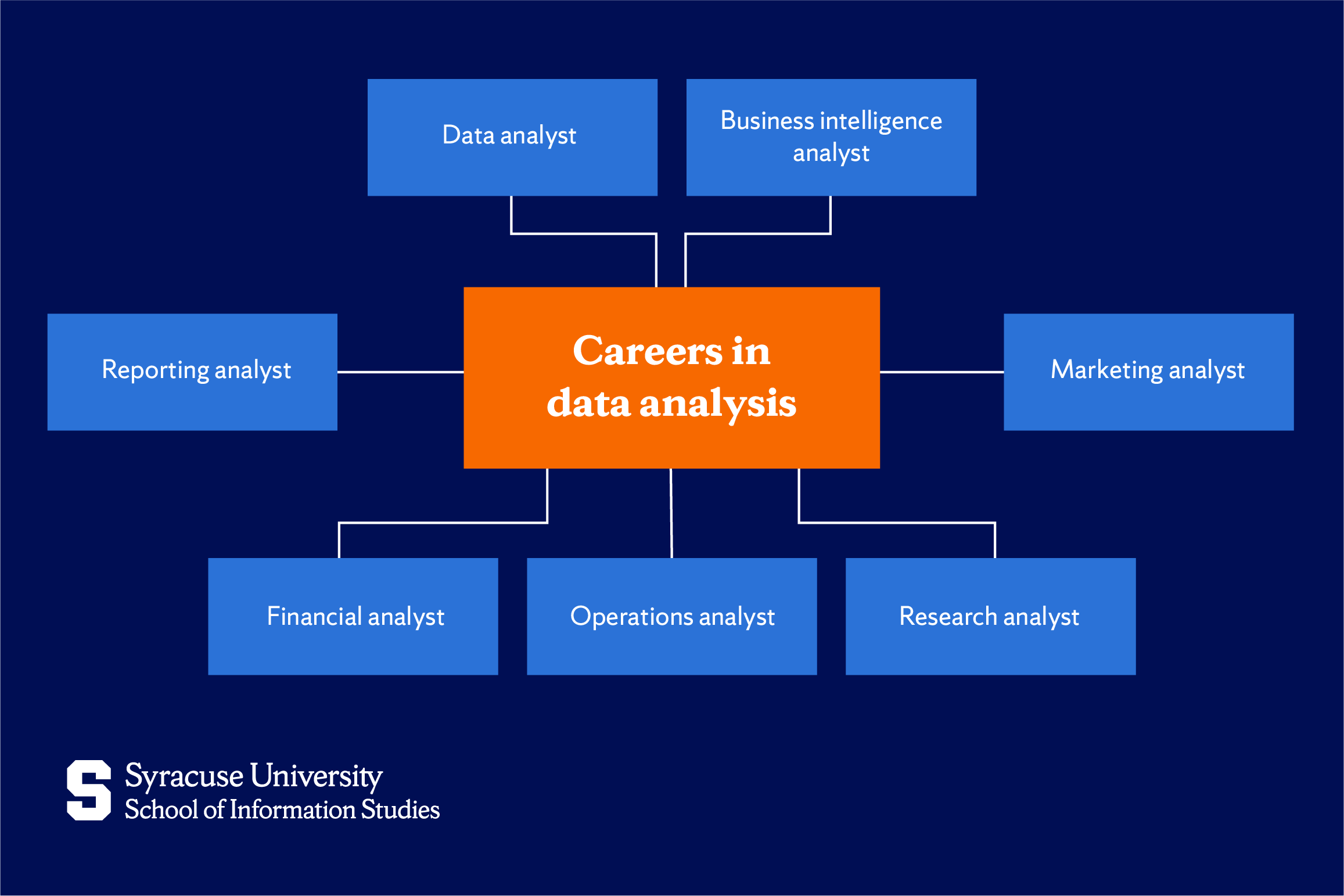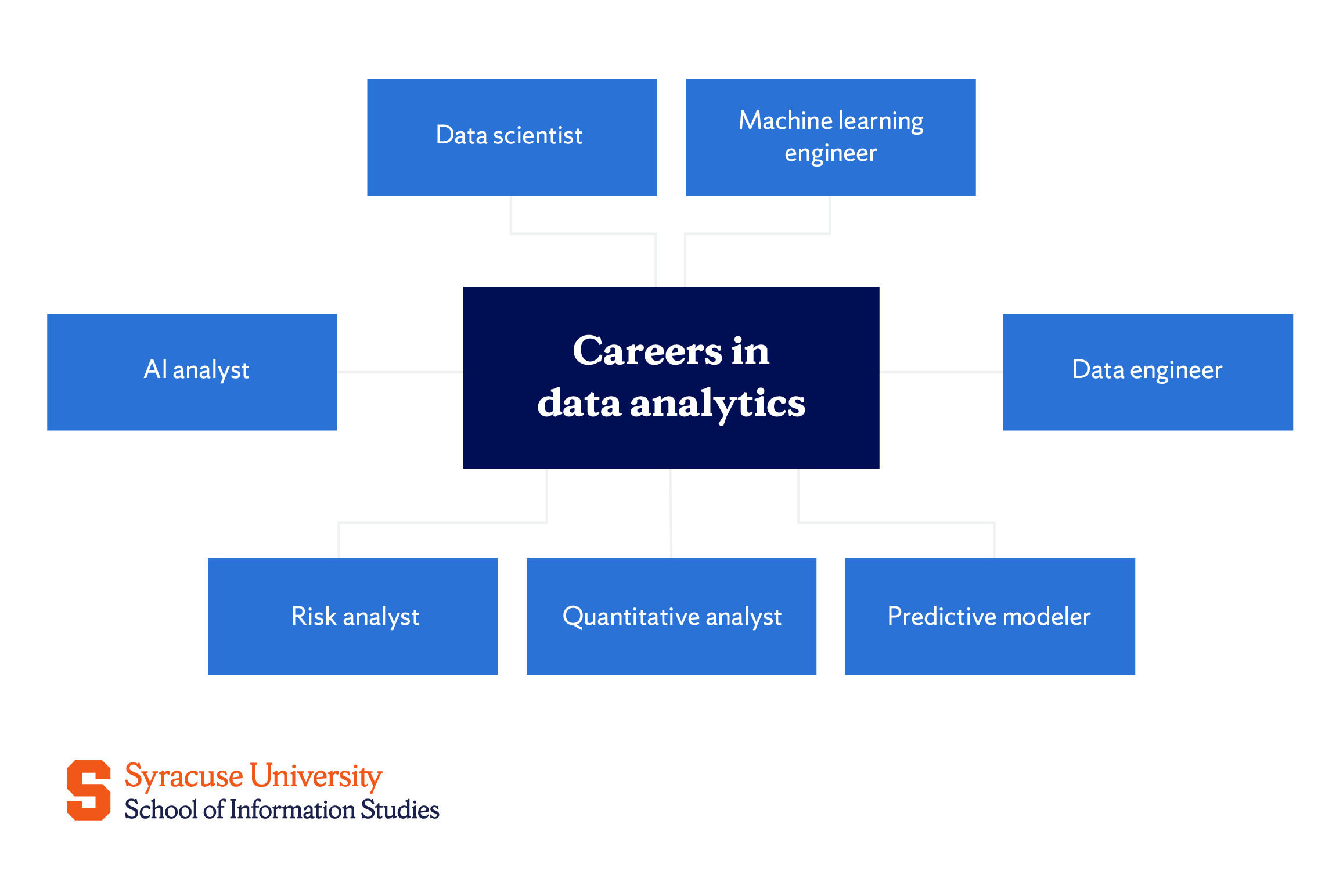Key Takeaways
- Data analysis focuses on examining data to understand past trends, while data analytics uses data to make predictions and guide future decisions.
- Both fields (data analytics and data analysis) are used across different industries to aid decision-making.
- Data analytics and data analysis generally differ in purpose, methods, tools used, and how they help solve problems.
It’s a common misconception that data analysis and data analytics are one and the same. With names that sound nearly identical and an obvious shared connection to working with data, it’s easy to assume they might be interchangeable. However, though they may seem like variations of the same concept, the words analysis and analytics point to two very different approaches.
To really grasp the difference that a single word can make in a job title or academic path, let’s look at data analytics vs. data analysis side by side.
What Is Data Analysis?
When a company summarizes its quarterly performance in a report or adjusts a product based on user feedback, they are using data analysis to make these decisions. It’s a field that takes on an important role in determining decisions across every industry.
Data analysis refers to the act of examining raw facts in order to extract meaning and turn them into useful knowledge. It typically revolves around answering what has happened and why it happened. It might use data from survey results, performance metrics, or even feedback forms and then transform that information into insights.
The process of data analysis generally starts with collecting data, which is then cleaned to remove any inconsistencies or errors that it may contain. From there, the data is organized and sorted in a logical and convenient way, like by date, category, or location, and then summarized by condensing the key information.
Data analysis doesn’t always look the same. It can involve working with numbers (quantitative analysis), exploring text and stories (qualitative analysis), or engaging with stakeholders directly in participatory approaches.
What Is Data Analytics?
Consider how political campaigns anticipate voter behavior or how streaming services consistently offer relevant content. These results are not lucky guesses but rather predictions driven by the application of data analytics.
Data analytics uses data to find patterns, forecast future behavior, and even prescribe actions. Essentially, it’s a broader discipline than data analysis that begins with collecting large volumes of structured or unstructured data, cleaning, processing, and then applying statistical models, machine learning algorithms, or data mining techniques.
While the process can vary based on industry or goal, data analytics often combines complex computational methods with business knowledge to support high-level decision-making.

Key Differences Between Data Analysis and Data Analytics
Data analysis and data analytics differ in several fundamental ways, including their aims, approaches, methods, and how their insights are used. While both fields help organizations make sense of information, one tends to be more reflective while the other is forward-looking.
Goal
Technically, both data analysis and data analytics aim to gain insight from data. But the direction of that insight is where they diverge.
The primary goal of data analysis is to break down past data in order to describe what has already happened and, in some cases, explain why it happened. So, essentially, it helps clarify outcomes by summarizing and interpreting historical patterns. Data analytics, on the other hand, is used to project what’s likely to happen next and support decision-making that focuses on the future.
So, a big difference between data analysis and data analytics is how the data is used: data analysis explains the past, while data analytics helps guide the future.
Focus
Data analysis and analytics areas of focus aren’t quite the same either. The former concentrates on identifying meaningful insights in existing datasets, often through straightforward techniques such as calculating averages, looking at frequency counts, or generating standard reports. It helps answer questions such as: “What happened?” and “How often did it occur?”
Data analytics, however, digs much deeper. Its focus stretches to relationships, patterns, and probabilities. This broader focus is particularly useful when organizations want to forecast demand or identify risks before they happen.
Methods
The techniques used in data analysis are generally more straightforward and help analysts summarize what has occurred and provide a clearer picture of the past. These methods include:
- Descriptive statistics
- Inferential statistics
- Hypothesis testing
- Regression analysis
- Correlation analysis
- Data visualization (e.g., charts, graphs)
- Trend analysis
- Data cleaning and preparation
- Comparative analysis
In accordance with their broader focus, data analytics relies on more complex and computationally intensive methods, such as:
- Predictive modeling
- Machine learning algorithms
- Data mining
- Big data processing
- Clustering
- Neural networks
- Natural language processing (NLP)
- Prescriptive analytics
- Time series forecasting

Common tools
The tools used in each field also reflect the nature and depth of the work. For data analysis, tools are generally designed for handling smaller, structured datasets. These include platforms like Microsoft Excel, SPSS, Google Analytics, and Tableau. These tools enable users to generate charts, perform calculations, and produce dashboards without needing to write complex code.
Data analytics, by comparison, uses tools that are better suited for handling large-scale, often unstructured data and require more technical expertise. Popular choices include programming languages like Python and R, data processing engines such as Hadoop and Apache Spark, as well as machine learning libraries like scikit-learn or TensorFlow. These tools are designed to work with massive volumes of data and allow analysts to automate processes, build predictive models, and extract deep insights.
Use cases
In business, both fields are widely applied—but in different contexts and with different scopes. Data analysis is typically used in day-to-day reporting, reviewing performance, or understanding patterns in existing data. For example, a company might analyze monthly sales reports to determine which products are selling best in a particular region or to track seasonal changes in demand.
Data analytics plays a more strategic role in comparison. This discipline is used to build models that anticipate customer behavior, identify inefficiencies, or assess risks. For instance, an e-commerce platform might apply data analytics to recommend products based on browsing history, or a logistics firm might use it to optimize delivery routes and predict delays.
Careers in Data Analysis vs. Data Analytics
Considering the importance of data, both data analysis and data analytics have become highly sought-after fields. With organizations across every sector relying on data experts to guide their decision-making process, careers in either field offer strong job prospects and plenty of room for growth.
Some of the roles you can pursue in data analysis include:
- Data analyst
- Business intelligence analyst
- Marketing analyst
- Research analyst
- Operations analyst
- Financial analyst
- Reporting analyst

Career paths in data analytics encompass roles as:
- Data scientist
- Machine learning engineer
- Data engineer
- Predictive modeler
- Quantitative analyst
- Risk analyst
- AI analyst

Which One Should You Choose?
While both data analysis and data analytics offer promising career paths, their differences in focus, complexity, and application mean they suit different types of thinkers and problem-solvers.
Who should choose data analysis?
Data analysis is a good fit for detail-oriented individuals who enjoy working with structured information to explain what has happened and why. It often appeals to professionals who are strong communicators and can transform raw data into clear insights that help teams understand trends, performance, or customer behavior.
If you’re interested in roles that combine analytical thinking with business understanding—often in marketing, operations, or finance—data analysis offers a highly relevant and rewarding path.
Who should choose data analytics?
Data analytics is better suited for those who are comfortable with ambiguity and interested in building systems or models that not only explain but also predict and prescribe.
Data analytics typically requires a stronger foundation in programming, mathematics, and possibly machine learning. Therefore, the field is ideal for those who enjoy these subjects and want to help organizations prepare for what’s ahead, optimize performance, or innovate through data-driven insights—often working in roles across tech, healthcare, finance, or logistics.
The Final Word: Data Analysis vs. Data Analytics
The suggestions above can help guide your thinking, but they’re not rigid rules. You might find yourself drawn to one field even if it doesn’t match your background perfectly—and that’s okay. With dedication, the right training, and a willingness to grow your skills, success is possible in either path.
No matter which direction you take, a solid educational foundation is arguably one of the most important factors. You must understand how to work with data in both cases—if you’re aiming to become a skilled data analyst and if you’re looking to explore analytics and predictive modeling.
At Syracuse University’s iSchool, the Bachelor’s in Applied Data Analytics offers the kind of forward-thinking curriculum that prepares you for both worlds. You’ll gain the tools, techniques, and real-world insights to pursue a variety of different roles in multiple data-driven industries.
Frequently Asked Questions (FAQs)
Does data analytics include data analysis?
Yes, data analysis is often considered a component or even subfield of data analytics, which specifically focuses on interpreting data.
What industries benefit the most from data analysis and data analytics?
Industries like finance, healthcare, retail, marketing, and technology heavily rely on both fields to improve decision-making and benefit greatly from them.
What are some common challenges faced in data analysis vs. data analytics?
Data analysis often struggles with data quality and consistency, while data analytics typically face added complexity from large datasets and having to work with multiple data sources.
